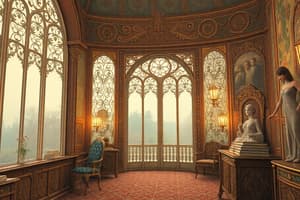Podcast
Questions and Answers
What does the term 'representational art' refer to?
What does the term 'representational art' refer to?
- Art that has no objects or symbols.
- Art that uses abstract shapes and forms.
- Art that represents identifiable objects or symbols. (correct)
- Art that consists solely of personal interpretations.
Which medium is NOT considered a form of visual art?
Which medium is NOT considered a form of visual art?
- Theater (correct)
- Painting
- Printmaking
- Sculpture
What is a primary function of arts in society?
What is a primary function of arts in society?
- To solely reflect the artist's solitary thoughts.
- To serve as a method for documenting historical events.
- To influence collective behavior in public spaces. (correct)
- To purely satisfy personal aesthetic enjoyment.
Which of the following is NOT a form of presenting art subjects?
Which of the following is NOT a form of presenting art subjects?
Which element of visual arts is characterized by visual perceptual properties such as red and blue?
Which element of visual arts is characterized by visual perceptual properties such as red and blue?
What is the definition of hue in relation to color?
What is the definition of hue in relation to color?
Which form of meaning in art involves personal interpretation by the artist?
Which form of meaning in art involves personal interpretation by the artist?
Which principle of design involves creating a feeling of movement through repetition?
Which principle of design involves creating a feeling of movement through repetition?
What describes non-representational or non-objective art?
What describes non-representational or non-objective art?
What does the principle of proportion refer to in design?
What does the principle of proportion refer to in design?
Which element of visual arts can be described as curves representing fluidity and grace?
Which element of visual arts can be described as curves representing fluidity and grace?
What is 'interposition' in the context of perspective?
What is 'interposition' in the context of perspective?
Which of the following best defines balance in an artwork?
Which of the following best defines balance in an artwork?
What is the purpose of variation in the principles of design?
What is the purpose of variation in the principles of design?
What does the phrase 'beauty is in the eye of the beholder' imply?
What does the phrase 'beauty is in the eye of the beholder' imply?
What aspect of color contributes to creating mood and symbolizing ideas?
What aspect of color contributes to creating mood and symbolizing ideas?
Flashcards are hidden until you start studying
Study Notes
Origins of Art
- Derived from Latin "Ars" meaning skill and Greek "Techne" meaning craft.
Creation of Art
- Artists draw upon personal experiences to create works like dance, paintings, poems, songs, and plays.
Creation of Materials
- Various materials and mediums are utilized to materialize artistic ideas.
Artistic Expression Forms
- Different forms serve as expressions of ideas, focusing on the physical nature of artworks.
Subjects of Art
- Person
- Nature
- Object
- Scene
- Event
Subject Classification
- Representational (Objective Art): Depicts identifiable objects or symbols; often tells stories.
- Non-representational (Non-objective Art): Lacks identifiable objects or symbols.
Presentation Techniques
- Naturalism
- Realism
- Abstraction (includes distortion, elongation, cubism)
- Symbolism
- Fauvism
- Dadaism
- Futurism
- Surrealism
- Expressionism
Content and Meaning
- Factual Meaning: Expresses truth or reality about the world or human experience.
- Conventional Meaning: Symbolic or special meanings associated with artworks.
- Subjective Meaning: Individual interpretation reflecting the artist's personal viewpoint.
Functions of Art
- Personal: A means for artists to express feelings and thoughts.
- Social: Affects collective behavior, often created for public engagement.
- Physical: Serves utilitarian purposes, used in architecture and community planning.
Mediums of Visual Art
- Painting
- Acrylic
- Fresco
- Watercolor
- Encaustic
- Mosaic
- Stained Glass
- Tempera
- Drawing
- Printmaking
- Intaglio and Etching
Elements of Visual Arts
- Line: Represents objects; types include horizontal (serenity), vertical (strength), curve (fluidity), and diagonal (movement).
- Shape: Can be natural, realistic, abstract, or non-objective; includes geometric forms.
- Texture: Visual representation of surface characteristics.
- Color: Derived from light spectrum; used to create mood, symbolize ideas, and express emotions.
- Value: Pertains to the lightness or darkness of a color.
- Space and Movement: Explored through techniques like perspective, overlapping, relative size, and linear perspective.
Design Principles
- Harmony: All elements complement each other.
- Variation: Elements contrast to avoid monotony.
- Rhythm: Flow of visual units creates movement through repetition.
- Proportion: Comparative relationships among composition elements, including size and color.
- Emphasis and Subordination: Highlights the significance of various parts within the artwork.
- Balance: Achieves unity; feels weight-balanced across elements.
Concepts of Beauty and Essentials
- Beauty is subjective, defined by personal perception.
- Essentials are seen as things visible to the heart but not to the eye.
Studying That Suits You
Use AI to generate personalized quizzes and flashcards to suit your learning preferences.




